The Actor as Author of the Text he Acts
DOI:
https://doi.org/10.37467/gka-revhuman.v9.2642Palavras-chave:
Actor, Author, Text, Brando, Textual criticismResumo
We aim to demonstrate how the acting technique and skills of an actor may influence the intentions of a text’s author, showing him new paths through the human and emotional factors. We also aim to demonstrate that what is usually considered a “text” may not always be a fixed entity produced by a single isolated individual.
The analysis of the staging and film adaptation of Tennessee Williams’ A Streetcar Named Desire and the development of the character Stanley Kowalski by Marlon Brando, shows how he changed the written version of the play, shifting its core, interfering with the balance between the two main characters and helping to shape the cultural and historical attributes which rendered its particular place in art history. The text produced by the actor may, thus, assume an identical value to that of the dramatic script from which it developed, or even produce a higher impact.
Referências
Borlik, Todd A. (2007). Painting of a sorrow: visual culture and the performance of stasis in David Garricks’s Hamlet. Shakespeare Bulletin, Volume 25, Number 1, Spring, pp. 3-31. Retrieved from http://muse.jhu.edu/login?auth=0&type=summary&url=/journals/shakespeare_bulletin/v025/25.1borlik.html (24.5.2012)
Bouzereau, L. (Producer), & Kazan, E. (Director). (2006). A Streetcar on Broadway [Documentary]. USA: Warner Bros Entertainment.
Branch, T. (1989). Parting the waters: America in the King years 1954-1963. NY: Simon & Schuster.
Burks, D. G. (1987). Treatment is everything: the creation and casting of Blanche and Stanley in Tennessee Williams’s ‘Streetcar’. Library Chronicle of the University of Texas at Austin, 41, 16-39.
Cunningham, V. (2008) Shakespeare and Garrick. Cambridge: University Press.
Feldman, C. K. (Producer), & Kazan E. (Director). (1993). A streetcar named desire: the original director’s version, with comments. USA: Warner Bros Entertainment Inc.
Gibbs, A. (2003) The play's the thing: textual criticism and performance of King Lear. The University of Nottingham.
Grésillon, A. (1996) La double contrainte: texte et scène dans la genèse théâtrale. ITEM – Institut des textes & manuscrits modernes.
Halliday, M. A. K. & Hasan, R. (1976). Cohesion in English. London: Longman.
Kazan, E. (1988). A life. New York: Alfred A. Knopf.
Loehlin, J. N. (2005). Teaching through performance. Hodgdon, B. & Worthen, William B. A companion to Shakespeare and performance, Volume 36. Blackwell Companions to Literature and Culture, Wiley. Oxford: Blackwell Publishing, pp. 627-643.
Malarcher, J. (1994) How is it played? The actor as literary critic. Didaskalia. Louisiana State University.
Manso, P. (1994) Brando, the biography, NY: Hyperion.
Miller, A. (2009) A Streetcar named desire – Introduction – Regarding Streetcar. Edited by E. Martin
Murphy, B. (1992). Tennessee Williams & Elia Kazan: A collaboration in the theatre. Cambridge: University Press.
Rocklin, E. L. (Spring 1988). Producible interpretation: literary criticism and the performance possibilities of play-scripts. Journal of Dramatic Theory and Criticism, Vol. II, No. 2, pp. 149-174. https://journals.ku.edu/index.php/jdtc/article/viewFile/1683/1647 (24.9.2012)
Roncaglia, A. (1974-75). Principi e applicazioni di critica testuale. Roma: Bulzoni Editore.
Schickel, R. (2006). Elia Kazan – A biography. NY: Harper Perennial.
Staggs, S. (2005). When Blanche met Brando – The scandalous story of ‘A Streetcar Named Desire’. NY: St. Martin’s Griffin.
States, B. O. (2002). The actor’s presence – three phenomenal modes. In P. B. Zarrilli, (Ed.), Acting (re)considered – a theoretical and practical guide (pp. 99-105). London and NY: Routledge. Retrieved from http://xa.yimg.com/kq/groups/9956787/1303660820/name /Acting+(Re)considered.pdf (24.9.2012)
Williams, T. (2009). A streetcar named desire. Edited by E. Martin Browne. London: Penguin Books (Modern Classics).
Worthen, W. B. (2006) Texts, tools and technologies of performance: a quip modest, in response to R. A. Foakes. Shakespeare. 2: 208. https://doi.org/10.1080/17450910600983836
Downloads
Publicado
Como Citar
Edição
Seção
Licença
Os autores/as que publicam nesta revista concordam com os seguintes termos:
- Os autores/as terão os direitos morais do trabalho e cederão para a revista os direitos comerciais.
- Um ano após a sua publicação, a versão do editor estará em acesso aberto no site da editora, mas a revista manterá o copyright da obra.
- No caso dos autores desejarem asignar uma licença aberta Creative Commons (CC), poderão a solicitar escrevendo a publishing@eagora.org.









